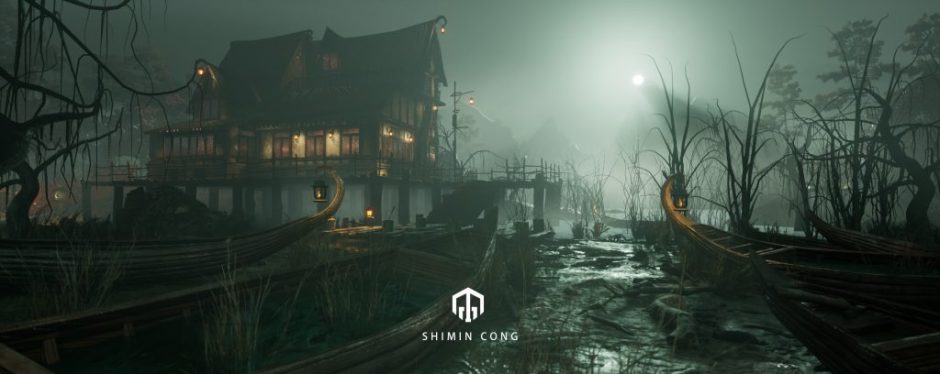Through the interactive course of the second week and the after-school video of the third week, I mainly learned the special lighting, motion blur, and destruction.
Special lighting

This effect is mainly controlled through the normal channel. The main work is carried out inside the attribvop node. The add node is to add a point which can control the direction of the light source.

Motion blur
The production of motion blur is similar to lighting. The biggest difference between the two is that one outputs color and the other outputs position.

The main method for this effect is to delay the action by 1-2 frames through the timeshift node, and merge the two models. The main operation content is also in attribvop.

Destruction
Voronoi

When making the destruction effect in Houdini, we have to mention Voronoi. Voronoi is a subdivision of the spatial plane. Its characteristic is that any position in the polygon is closest to the sampling point of the polygon, far away from the sampling point of the adjacent polygon, and each polygon contains and only contains one sampling point. In mathematics, a Voronoi diagram is a partition of a plane into regions close to each of a given set of objects. In the simplest case, these objects are just finitely many points in the plane (called seeds, sites, or generators).
Practice


First of all, for the Voronoifracture node, the most critical part is to import points. Therefore, scatter nodes are often used to obtain points on the surface of the model.


There are many ways to get points on the model. As shown in the figure above, this method is to obtain points information through the pointfromvolume node. Two effects are achieved by adjusting the internal parameters of the pointfromvolume node.

If we want to increase or decrease the number of points, scatter node and pointfromvolume node are best used together.

The third way to calculate the position of a point on the model is to use vdbfrompolygon node. The function of the vdbfrompolygon node is to convert the solid polygon into a fog effect. By capturing the fog point through the scatter node, some good effects will be obtained. Of course, we can also merge some points on the surface of the model.

In the process of making the destruction, we must try to restore its details, such as the shape of the crack.
In the previous exercises, I focused on different methods of capturing points. Therefore, the cracks produced are all very straight lines. The solution to this phenomenon is to add a noise to the model.
However, new problems will also arise. After adding noise, we found that although the cracks of the model have reasonable bending. But the model itself has also been deformed, which is not in line with reality. For this, we need to add attribwrangle node to control, by writing code, to achieve the opposite effect of rest node. Furthermore, the details of the cracks are preserved, and the deformation of the model is also cancelled.

This desturction effect is mainly similar to the appearance of an object after being cut multiple times. Its main working principle is to make some planes and subtract objects with boolean nodes.
Among them, the attribrandomized node is mainly a random angle of the control plane. The function of the Copytopoint node is to transform the points into a model through the information of the import points and the information of the model.

The production principle of the wood effect is mainly to stretch the previous average crushing. In this process, it is mainly controlled by controlling the transform node.


Compare the previous several different methods to make destruction. The rbdmaterialfracture node will be simpler and will have better results.

After testing the broken model, we have to conduct some physical tests. For example, falling objects.


As shown in the figure, the nodes in the video show that the process is mainly carried out in the dopnet node.

In this process, the point we have to consider is that the model should be packaged_create packed geometry.

Under normal circumstances, in the process of making destruction, we also need to consider the role of glue. That is, there is attraction between groups and groups. This will make the effect more realistic.
This effect is mainly controlled by the second output node of rbdmarteialfracture node.



We then simulate the collision between objects. As shown in the figure above, a big problem is that the position of the cabin has moved.


To solve the above problems, the solution is to divide the cabin into two groups. One is movable and the other is immovable.
After dividing into groups, two attribcreate nodes are used to control whether the collision effects of the two groups are triggered. Mainly use float 0 and 1 to control.


The last effect is a combination of glass, concrete and wood destruction. For wood materials, the rbdmatreialfracture node can indeed achieve very good results, but it takes a lot of time to calculate. For this, the method shown in the figure is adopted. Obtain model points information through two nodes vdb and scatter. At the same time, the transform node is used to handle the effect of crack stretching.
After dividing into groups, two attribcreate nodes are used to control whether the collision effects of the two groups are triggered. Mainly use float 0 and 1 to control.
In short, in the process of making destruction, we have to consider the crack shapes of different materials, the interactive and non-interactive areas, and the glue between groups.
